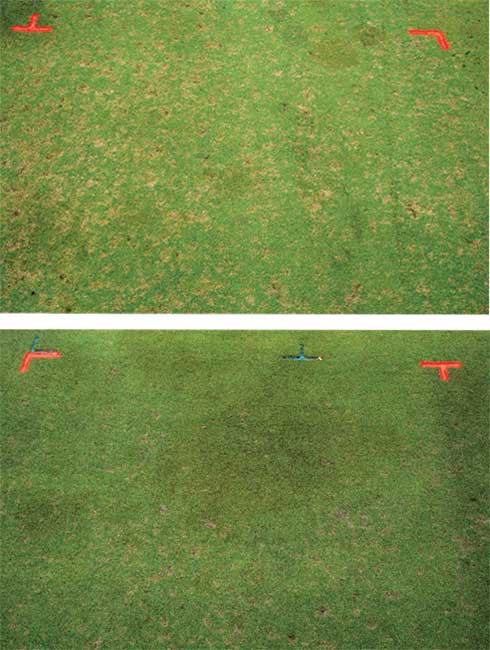Ferrous sulfate for dollar spot suppression

Dollar spot suppression with ferrous sulfate (FeSO4) applied at 0 (untreated control-top), 0.5 and 1 lb. per 1,000 sq. ft. on a 007 creeping bentgrass putting green.
Researchers at Virginia Tech demonstrated in 2012 that ferrous sulfate applied at 1 lb./1,000 sq. ft. (20 percent ferrous sulfate-heptahydrate) can reduce dollar spot pressure without traditional fungicides. Because previously tested ferrous sulfate rates were so high, trials were established to determine if lower rates also can provide desired control.
Studies were conducted at the Virginia Tech Turfgrass Research Center in Blacksburg, Va. in 2016 on a 007 creeping bentgrass (Agrostis stolonifera) putting green and an L-93 creeping bentgrass fairway. Ferrous sulfate was applied at five rates (0, 0.1, 0.5, 1 and 2 lbs./1,000 sq. ft.) every 14 days and evaluated weekly for its ability to reduce dollar spot.
After one season, our data suggest that rates can be reduced to 0.5 lbs./1,000 sq. ft. without compromising efficacy. The reduction was evident on both greens and fairway trials, but this research needs to be repeated in 2017 to validate our findings.
It was apparent that this strategy alone would not be sufficient for acceptable control. Therefore, we have begun investigating how the use of ferrous sulfate may impact a chlorothalonil fungicide program. Our data suggest that ferrous sulfate can extend the longevity of dollar spot control with chlorothalonil (3.6 fl. oz./1,000 sq. ft. Daconil WeatherStik) by five days. We also are investigating how ferrous sulfate applied in conjunction with chlorothalonil can maintain dollar spot below an acceptable threshold while reducing the total amount of chlorothalonil applied per year. This research may help turf managers adhere to annual site-use limitations of chlorothalonil while still achieving acceptable dollar spot control throughout the season.
Camden Shelton, David McCall, Ph.D., Erik Ervin, Ph.D., and Shawn Askew, Ph.D., Virginia Tech University. Reach Cam Shelton at cam1@vt.edu for more information.
Photo by: Camden Shelton









